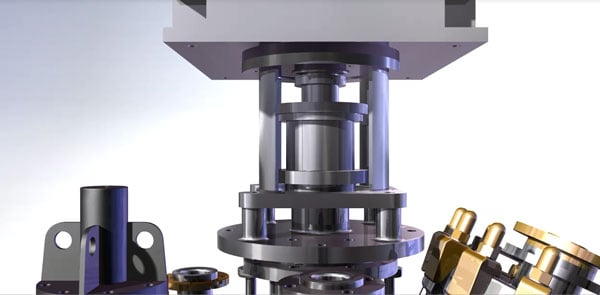Correcting Improper Performance of Mechanical Seals [Part 2]

Last week we answered some of your most frequently asked questions about mechanical seals, including life expectancy, wet vs. dry, common operating mistakes, symptoms of problematic seal, and the short and long term problems of a leaking seal. Get up to speed on the discussion by reading the first post if you haven’t already done so. We’ll continue our discussion about potential seal issues and ways that you can proactively avoid these problems in your equipment.
Q: What practices should be avoided because they can cause seal problems?
Many seal problems are caused by running the agitator at vessel conditions that cause high agitator inaccuracy or “runout”. The following agitation “don’ts” should be avoided to ensure maximum seal life.
- Do not start the agitator when it is buried in solids.
- Do not run the agitator at full speed while the vessel is empty.
- Do not run the agitator at full speed with the liquid level the agitator blade level.
- Do not run the agitator at full speed during boil-off, especially if the product increases in viscosity.
- Do not run the agitator at full speed during slow draining of the vessel, especially if the liquid level will be at the blade level for any appreciable time.
- Do not run the agitator outside the operating parameters of the equipment.
- Do not run the agitator at higher speeds than are recommended at various liquid levels.
- Do not run the agitator with improperly maintained drives.
-For Agitator Do’s see Agitator Do’s and Don’ts tip sheet
Q: What kind of maintenance should be performed to help prevent seal problems?
A: Maintenance of the seal depends on checking the seal for leakage as well as maintenance of the drive/gearbox. For dry seals the consumption of nitrogen should be checked with a rotameter, which measures in cubic feet per hour, at least once a day. When the consumption of nitrogen increases that is a warning the seal could be failing. For lubricated seals, monitor the consumption of barrier fluid in the lubricator. When the consumption of barrier fluid increases, that is an indication of seal failure.
The agitator runout should be measured at least once per year or after an increase in nitrogen or barrier fluid is noticed. The runout must be measured before the drive is disassembled after a seal failure and during reassembly of the drive during the installation of a new seal. The bearing float of the drive gearbox should be checked at least once per year and especially after a seal failure. If the drive loses the pre-load in the output bearings then it will cause higher than normal runout which will lead to seal failure.
Q: What are the most common seal issues and what should be done to fix them?
A: The most common seal issues which cause increased nitrogen or barrier fluid consumption or leakage of the vessel contents into the atmosphere are:
- Worn or chemically attacked rotating faces
- Cut, nicked or chemically attacked O-rings
- Over-pressurized or under-pressurized seal housing
- Higher than normal runout of the agitator shaft
- Lack of maintenance of the gearbox which can cause higher than normal runout
The action steps that should be taken to fix these problems include:
- If the seal is new: Remove the seal cartridge and check the parts mentioned above.
- If the seal has been used for a period of time: Remove and replace the seal cartridge and replace it with a new one. Clean the seal and send it back to the manufacturer it was purchased from for evaluation or possible rebuilding. Do not send back un-cleaned seals.
- For OptiSeals: Remove the seal and rebuild it with a factory authorized Rebuild Kit or replace it with a new seal, clean the old seal and send it back to DDPS for evaluation or rebuilding.
Q: How do you know when you should fix a seal vs. replace it?
A: When a dry seal is new, sometimes it will leak more than the allowable limit (two cubic foot per hour per inch of shaft diameter) it can be fixed by gradually increasing the pressure and running the agitator until the leakage comes back into the correct range. If a dry seal leaks after running for a time, the nitrogen lines need to be checked for leakage and soapy water sprayed on the top of the seal. If the soap bubbles, then the seal is leaking and the seal cartridge must be replaced or sent back for rebuilding. If this is an OptiSeal, then a rebuild kit needs to be installed. Dry seals that have been in service for more than a year and show an increase of nitrogen consumption should have the seal cartridge replaced.
When wet seals start to leak after running for a year or two, the cartridge must be replaced. If a wet seal leaks shortly after being put into service, it must be removed, all O-rings must be checked for nicks or cuts and the faces checked for scratches. The O-rings can be replaced. If the faces are scratched, then the cartridge should be returned to the manufacturer it was purchased from and the cartridge replaced. If no damage can be found, then the seal can be re-installed, paying close attention to assembly details. For both types of seals, the shaft runout must be checked at this time to make sure the agitator is running within acceptable parameters.
In short, if the seal is new, then it might be able to be repaired, but if the seal has been running for any appreciable time, then the cartridge must be replaced.
Q: If you have a seal that is running adequately, is there anything you can do to further optimize the performance?
In short, if you follow the rules of your mixing system and observe the efficiency of your mechanical seal on a regular basis you can help to extend its life and maintain its efficiency. The top three tips for optimizing your seals performance are:
- Keep monitoring the nitrogen or barrier fluid consumption.
- Keep monitoring the pressure in the seal housing and vessel.
- Follow Agitator Do’s and Don’ts (link to landing page with tip sheet pdf download)
Mechanicals seals have a tough job and they certainly experience a lot of wear a tear due to their constant use. If you haven’t tried the new OptiSeal design, it is definitely worth inquiring about during your next seal replacement to see if your process is a good candidate. In the meantime, to help keep your mechanical seal well maintained we’ve created a handy tip sheet on Agitator Do’s and Don’ts that you can download and share with your coworkers. It contains important information including best practices that will help keep your mixing system in optimal condition. If you have any additional questions about mechanical seals that weren’t answered in this article contact us and we’d be happy to assist you.

